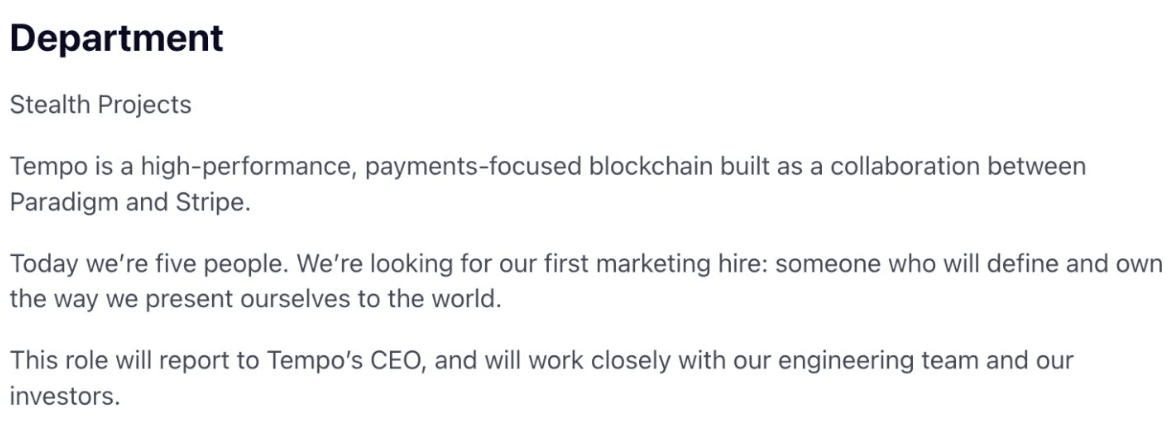Original Title: (Payment Giant Stripe Secretly Develops New Chain 'Tempo', Integrating Bridge and Privy for Seamless Stablecoin Payments)
Original Author: Joe, BlockTempo
A job description provides a glimpse into the next steps that Stripe is brewing: a new blockchain named Tempo. According to a report by Fortune on August 11, the cryptocurrency lobbying group Blockchain Association recently posted new job openings, indicating that Stripe is hiring for product marketing positions for the new chain.

Image Source: Blockchain Association
Tempo Plan Exposed: The Secret Cooperation Between Stripe and Paradigm
According to the job description, Tempo is a "high-performance, payment-focused blockchain built in collaboration with Paradigm and Stripe," compatible with Ethereum, and developed by a five-person team in an "undisclosed mode."
After Fortune further sought confirmation from both companies but received no response, the job application has expired; however, the job content is still published online, and Stripe's new chain may be launched soon.
Vertical Integration: The Puzzle of Bridge, Privy, and Tempo
Looking ahead, Tempo is not a single-point attack; it is the final piece of the underlying puzzle in Stripe's stablecoin strategy.
In October 2024, Stripe acquired stablecoin infrastructure company Bridge for $1.1 billion; in June of this year, it also brought wallet developer Privy under its wing. Bridge provides stablecoin issuance and integration capabilities, while Privy is responsible for the end-user wallet experience. Now, with the chain-level processing from Tempo, Stripe can fully control everything from token minting to transaction settlement.
In the future, corporate clients may be able to complete stablecoin payments through Stripe in a single interface, even bypassing the SWIFT network for second-level cross-border settlements.
Policy and Market Environment: The Boom of Stablecoins Provides Nutrients
We know that stablecoins are seen as a tool to reduce cross-border payment costs, and countries are beginning to provide clear frameworks for regulation. Particularly, the GENIUS Act signed by President Trump in July for the first time defines the status of stablecoins at the federal level, clearing legal doubts for companies in the future.
Recently, tech giants have been testing stablecoin services, showing that demand is no longer limited to the native crypto space. Stripe CEO Patrick Collison stated plainly during a House hearing in March this year:
"As the underlying technology matures, we are seeing meaningful commercial interest in stablecoins."
This statement now seems more like a prelude to Tempo's low-key launch.
The Ripple Effects That Tempo May Bring
Tempo has not yet announced a specific launch date, but the timeline from acquisitions to recruitment news demonstrates ambition. The next competitive focus in the payment industry may shift from card fees to who can provide the fastest, cheapest, and most reliable stablecoin settlement services.
Stripe chooses to personally build the blockchain rather than simply integrating existing public chains, conveying a very clear message: to maintain dominance in the future global payment battlefield, one must control every critical path from the user end to the validating nodes. A payment reconstruction driven by stablecoins is accelerating.
Original Link
